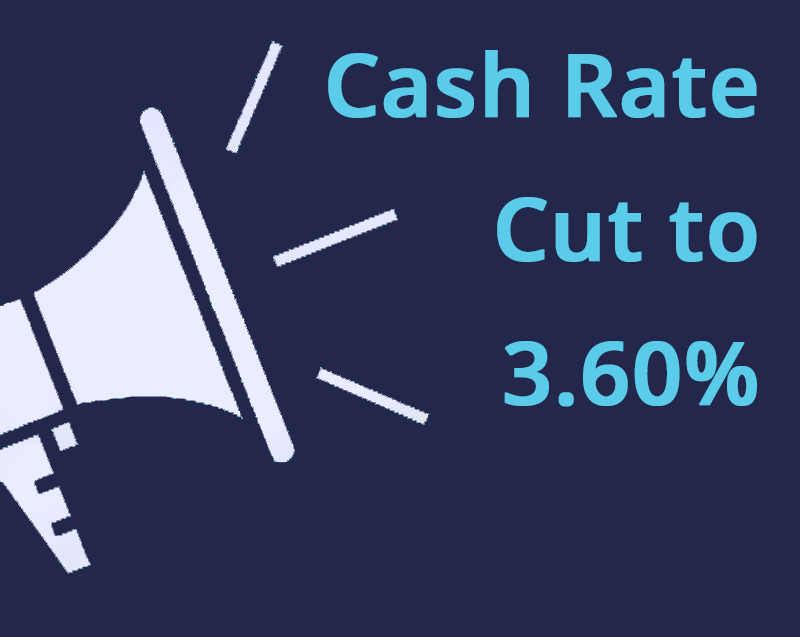In a widely anticipated move on 12 August 2025, the Reserve Bank of Australia (RBA) delivered a 25 basis point rate cut, lowering the cash rate from 3.85% to 3.60%, the third reduction this year. This rate is now at its lowest level since March 2023, signalling renewed monetary easing amid persistent economic fragility.
Governor Bullock emphasised that the decision was unanimous and that larger cuts weren’t considered. She did, however, leave the door open for further action if conditions warrant it. The unanimous decision was made because:
- Headline inflation has eased to 2.1% year on year, and the RBA’s preferred trimmed mean measure sits at just 2.4–2.7%, comfortably within the desired 2–3% range. So, it’s now within target.
- There’s still soft economic growth; quarter 1 saw GDP grow 0.2% and unemployment has gone up slightly to roughly 4.3%.
This is a welcome move for many with flow-on impacts across a broad section of the community.

Borrowing and mortgages:
A borrower with a $600,000 mortgage can expect monthly repayments to fall by around $89, saving over $1,000 annually.
Refinancing:
The latest cut has triggered a wave of refinancing. Canstar estimates monthly savings of around $272 on a $600,000 loan, potentially taking years off the loan term and saving tens of thousands in interest expenses.
Housing and lending:
The cut may revive home-buying sentiment, though the risks of swelling property prices remain. Borrowers and buyers alike are feeling the relief.
Currency and markets:
The Australian dollar did weaken moderately following the decision. On the ASX 200, financial stocks, notably the Commonwealth Bank, took a hit as investors fretted over shrinking interest margins.
Lower interest rates ripple across the investment landscape:
Lower interest rates stimulate the economy by increasing investment and household consumption, which leads to higher domestic output (GDP).
Investors are encouraged to borrow and invest in projects, while households spend more by saving on mortgage payments.
Lower rates also support higher asset prices (think share markets and property), which can boost household wealth and spending. These combined effects result in increased demand for goods and services and higher economic activity.
🔑 Key takeaways
- Borrowers: Strong relief through lower mortgage repayments, refinancing opportunities, and improved property sentiment.
- Investors: Mixed effects – equities and property benefit, but fixed-income returns (term deposits and bonds) fall; real estate demand may strengthen.
- Retirees: Cash, term deposit, and bond income weaken, super balances may rise, but managing volatility and inflation (to preserve purchasing power) remains critical.
- Economy overall: Stimulates borrowing and spending, though risks of overheating in housing or misallocated capital remain
More on what it means for Borrowers
Now is an ideal time to review your current lending arrangements. Many lenders have already adjusted their rates, creating opportunities to secure a more competitive interest rate and potentially reduce your repayments.
Even a slight decrease can make a meaningful difference over the life of your loan. If it’s been some time since your last review, it may be worthwhile to explore whether refinancing could deliver savings or better align your loan with your current goals.
More on what it means for investors
- Equities: With more disposable income in the economy, there is usually more money to invest in stocks, leading to a shift in money from bonds.
- Bonds and Fixed Income: With yields declining, existing bondholders benefit from higher prices, but reinvestment risk grows for those relying on bond income. Investors may shift toward riskier assets (equities) in search of better returns.
- Property and Alternatives: Lower rates may further boost real estate demand, driving capital appreciation but also increasing affordability concerns. Alternatives such as infrastructure may gain traction as investors diversify away from traditional fixed income.
- Global Investors: Foreign capital flows may adjust in response to a weaker AUD, influencing both valuations and the competitiveness of Australian exports. If the AUD weakens, this makes our market more attractive to investors from overseas.
More on what it means for retirees
- Income Pressure: Those relying on term deposits, annuities, or bonds will see lower returns, potentially forcing a rethink of income strategies.
- Cost of Living: While inflation is now within target, retirees on fixed budgets remain sensitive to rising essentials such as healthcare and housing. But easing rates tends to lessen the cost-of-living pressures across all demographics.
- Superannuation and Pensions: Super fund performance may benefit from rising equity and property values, but volatility and risk remain concerns for those drawing down balances.
- Capital Preservation vs Growth: Many retirees may feel compelled to move further up the risk curve to maintain income, but this raises questions about portfolio resilience in the face of market shocks.
The Bottom Line
While there are always winners and losers, for many Australians, this is a positive change.
Borrowers and home buyers feel immediate relief, while investors and retirees face a more complex landscape—balancing opportunity with caution.
Either way, please reach out if we can help you understand how to best manage your debt, explore refinance options or evaluate investment readiness in light of these changes.



